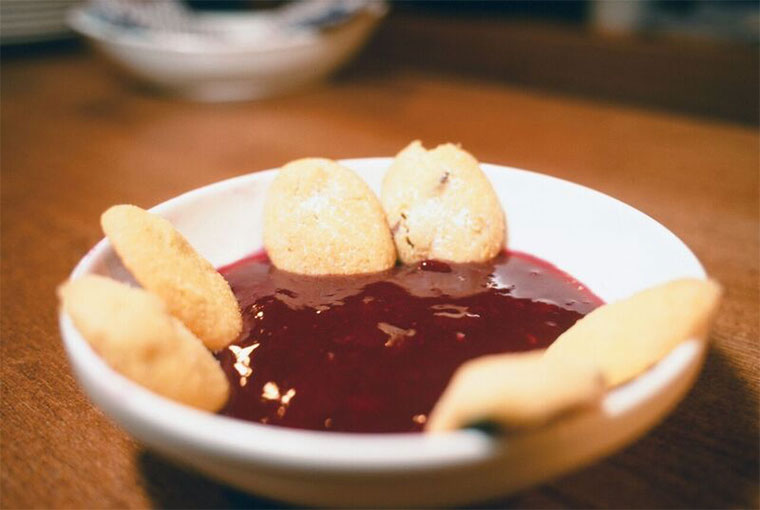“Zaletti” (Gialletti)
Venice’s Golden Cookies
Makes about 4 dozen cookies
Adapted from Veneto: Authentic Recipes From Venice and the Italian Northeast, by Julia della Croce
A glass of prosecco and a basket of traditional Venetian cookies greet everyone who comes on board the Eolo, Mauro Stoppa’s historical sailboat. One of my favorites are zaletti, whose name derives from giallo, Italian for “yellow;” gialletti, or “little golden ones” becomes “zaleti” or “zaletti” in Venetian dialect. Made from a mixture of finely ground polenta and wheat flour, they are pleasantly grainy, ideal for dunking into prosecco, espresso, or a fruit puree like the one Mauro makes using grapes.
Currants or raisins and sometimes, pine nuts stud the dough, but you can use any dried fruit or nut you like as long as they are chopped into small pieces to make a neat business of slicing the cookie dough. To duplicate the polenta used in Venice for these cookies, use the finely ground variety. Some original versions of zaletti call for a dough using both lard and butter in a ratio of 1:2, though modern recipes typically use butter alone. While their texture is naturally somewhat “al dente,”zaletti are meant to be chewy as well. Take care not to over-bake and you’ll have the perfect cookie for eating directly or dunking.
•4 ounces (3/4 cup) dried currants or chopped raisins
•2 tablespoons flour (dip into flour container and level) + 1-1/2 cups (7 ounces) unbleached all-purpose flour, spooned into dry measuring cups to overflowing and sweeping off excess to level)
•11 tablespoons (1 stick + 3 tablespoons, or 5-1/2 ounces) unsalted butter at room temperature
•1/2 cup granulated white sugar
•2 large eggs, at room temperature
•2 tablespoons rum or Cognac
•1 cup fine polenta, instant or traditional
•2 teaspoons baking powder
•3/4 teaspoon fine salt
•confectioners’ sugar for dusting (optional)
Method:
1. In a small bowl, toss together the currants or chopped raisins with the 2 tablespoons of flour and set aside.
2. In the bowl of a stand mixer or in an ample mixing bowl using a portable electric mixer, beat the butter and sugar together until smooth, 1-2 minutes. If using a stand mixer use the flat beater. Break in the eggs one at a time and beat each in thoroughly with the flat beater. Switch to the whip attachment and slowly drizzle in the alcohol while beating on medium speed. Beat until smooth and fully combined.
3. In a separate bowl, whisk together thoroughly the 1-1/2 cups flour, polenta, baking powder, and salt.
4. By hand, using a wooden spoon, or on low speed with the flat beater, stir in the dry ingredients and the dried fruit into the beaten butter mixture until well incorporated. The dough will be thick and wet.
5. Scrape the dough onto a lightly floured work surface and toss around to coat lightly with flour. Pat the dough into a 6-inch square and divide the dough into four equal sections. Each will weigh about 7.5 ounces. Roll each section into cylinders about 7 inches long and 1-inch in diameter. Wrap each well in plastic film. Set the rolls on a baking sheet and refrigerate for about 1 hour or until the dough is firm enough to slice easily. Alternatively, you can refrigerate the dough cylinders overnight or for up to 1 week, or freeze them for up to 2 months. If freezing, when you are ready to bake, thaw the rolls until they are firm enough to slice neatly.
6. When you are ready to bake, adjust an oven rack to the center position and preheat the oven to 375 degrees F. Line two large baking sheets (17 x 12 x 2-inches) or cookie sheets (14 x 17-inches) with bakers’ parchment.
7. Slice each cylinder into fourteen 1/2-inch rounds; place them, about 2 inches apart, on the prepared baking sheets, and press on them gently with two fingers to flatten them to a thickness of about 1/4-inch. I put 24 cookies on a large cookie sheet.
8. Bake one sheet at a time until the cookies are golden on top and cooked through, about 15 minutes, rotating the pan halfway through to bake them evenly. Remove the cookies from the oven at once and transfer them to a wire rack to cool.
9. Serve warm or at room temperature, first dusted with confectioners’ sugar, if you like.
Note: If you slice 56 cookies, you’ll have 8 extra to bake separately. Zaletti are best if stored in an airtight container in the refrigerator for up to two weeks.































